Performance of GLASS and MODIS Satellite Albedo Products in Diagnosing Albedo Variations during Different Time Scales and Special Weather Conditions in the Tibetan Plateau
Abstract
:1. Introduction
2. Data and Methods
2.1. Remote Sensing Albedo Products
2.1.1. GLASS Product
2.1.2. MODIS Products
2.2. In Situ Measurements
2.2.1. Grassland Observation Site in Maqu
2.2.2. Grassland Observation Site in Maduo
2.3. Methods
2.3.1. Calculation of 8-Day Average Albedo of GLASS and MCD43B3
2.3.2. The Blue-Sky-Albedo of MCD43A3
2.3.3. Interpretation of Statistical Metrics Used
3. Results
3.1. Evaluation of 8-Day Average Albedo
3.2. Seasonal Distribution of 8-Day Albedo
3.3. Surface Albedo Changes Under Special Weather Conditions
3.3.1. Effect of Snowfall on Daily Albedo
3.3.2. Effect of Rainfall on Daily Albedo
4. Discussion
5. Conclusions
- (1)
- In an 8-day timescale, the ground-based albedos are concentrated in 0.16–0.67 and 0.16–0.76 at Maqu and Maduo sites, respectively. The BSA of GLASS and MCD43B3 are less than the average ground-based observation of Maqu by 0.030 and 0.027. GLASS’s BSA albedo coincides well with the ground-based observation in Maduo, with RMSE of 0.092 and R of 0.833, while that of MCD43B3 had an RMSE of 0.072 and R of 0.752. But they are underestimated when the albedo is greater than 0.4. The 8-day albedo of this period happened to be averaged based on the number of snow-covered days.
- (2)
- In seasonal timescale, the ground-based albedos vary with the largest range in winter and the smallest in summer, which are 0.20–0.67 and 0.17–0.22 at Maqu site and 0.19–0.74 and 0.17–0.21, respectively. The BSA of GLASS and MCD43B3 underestimated the ground-based observation of Maqu by 0.015 in summer, while their WSA are slightly overestimated and closer to the ground-based observation. The maximum biases of GLASS and MCD43B3 albedos from Maduo ground-based observation are 0.042 and 0.053 in summer and 0.155 and 0.171 in winter, respectively.
- (3)
- Under special weather conditions, the response of surface albedo to soil moisture is different in semihumid and semiarid areas in summer. For both sites, the blue-sky-albedo of MCD43A3 has better agreement with the ground-based albedo than the GLASS and MCD43B3, as it is more suitable for reflecting the albedo changes in a short period by improving the temporal resolution, and calculates the albedo by weighting multiple observations within 16 days to be closer to the actual surface. However, it still missed capturing the slowdown processes of albedo changes resulted by small snowfall processes or the snow aging due to the cloud cover and inversion algorithms. GLASS and MCD43B3 albedos are frequently small and have the missing or misrepresentation of rapid changes in albedo caused by snowfall and rainfall on the TP.
Author Contributions
Funding
Acknowledgments
Conflicts of Interest
References
- Dickinson, R.E. Land surface processes and climate-surface albedos and energy balance. Adv. Geophys. 1983, 25, 305–353. [Google Scholar]
- Baret, F.; Schaaf, C.; Morisette, J.; Privette, J. Report on the second international workshop on albedo product validation. In Michael King, EOS Project Scientist, NASA’s Earth Observing System Project Science Office, USA. Earth Obs. 2005, 17, 13–17. [Google Scholar]
- Hall, A. The role of surface albedo feedback in climate. J. Clim. 2004, 17, 1550–1568. [Google Scholar] [CrossRef] [Green Version]
- Cess, R.D. Biosphere-albedo feedback and climate modeling. J. Atmos. Sci. 1978, 35, 1765–1768. [Google Scholar] [CrossRef]
- Barry, R.G.; Chorley, R.J. Atmosphere, Weather and Climate; Routledge: New York, NY, USA, 2009. [Google Scholar]
- Davidson, A.; Wang, S.S. The effects of sampling resolution on the surface albedos of dominant land cover types in the North American boreal region. Remote Sens. Environ. 2004, 93, 211–224. [Google Scholar] [CrossRef]
- Liang, S.L. Narrowband to broadband conversions of land surface albedo I: Algorithms. Remote Sens. Environ. 2001, 76, 213–238. [Google Scholar] [CrossRef]
- Engelsen, O.; Pinty, B.; Verstraete, M.M.; Martonchik, J.V. Parametric Bidirectional Reflectance Factor Models: Evaluation, Improvements and Applications; Joint Research Centre, Ed.; Technical Report EUR 16426 EN; Office for Official Publications of the European Communities: Ispra, Italy, 1996. [Google Scholar]
- Liang, S.L.; Strahler, A.H.; Walthall, C. Retrieval of land surface albedo from satellite observations: A simulation study. J. Appl. Meteorol. 1999, 38, 712–725. [Google Scholar] [CrossRef]
- Lucht, W.; Schaaf, C.B.; Strahler, A.H. An algorithm for the retrieval of albedo from space using semiempirical BRDF models. IEEE Trans. Geosci. Remote 2000, 38, 977–998. [Google Scholar] [CrossRef] [Green Version]
- Jin, Y.; Gao, F.; Schaaf, C.B.; Li, X.W.; Strahler, A.H.; Bruegge, C.J.; Martonchik, J.V. Improving MODIS surface BRDF/albedo retrieval with MISR multiangle observations. IEEE Trans. Geosci. Remote 2002, 40, 1593–1604. [Google Scholar]
- Qu, Y.; Liu, Q.; Liang, S.L.; Wang, L.Z.; Liu, N.F.; Liu, S.H. Direct-estimation algorithm for mapping daily land-surface broadband albedo from MODIS data. IEEE Trans. Geosci. Remote 2014, 52, 907–919. [Google Scholar] [CrossRef]
- Diner, D.J.; Martonchik, J.V.; Kahn, R.A.; Pinty, B.; Gobron, N.; Nelson, D.L.; Holben, B.N. Using angular and spectral shape similarity constraints to improve MISR aerosol and surface retrievals over land. Remote Sens. Environ. 2005, 94, 155–171. [Google Scholar] [CrossRef]
- Wen, J.G.; Dou, B.C.; You, D.Q.; Yong, T.; Qing, X.; Liu, Q.; Liu, Q.H. Forward a small-timescale BRDF/Albedo by multisensor combined BRDF inversion model. IEEE Trans. Geosci. Remote 2017, 55, 683–697. [Google Scholar] [CrossRef]
- Wu, X.D.; Wen, J.G.; Xiao, Q.; You, D.Q.; Dou, B.C.; Lin, X.W.; Hueni, A. Accuracy Assessment on MODIS (V006), GLASS and MuSyQ Land-Surface Albedo Products: A Case Study in the Heihe River Basin, China. Remote Sens. 2018, 10, 2045. [Google Scholar] [CrossRef] [Green Version]
- Lyapustin, A.; Wang, Y.; Kahn, R.; Xiong, J.; Ignatov, A.; Wolfe, R.; Wu, A.; Holben, B.; Bruegge, C. Analysis of MODIS-MISR calibration differences using surface albedo around AERONET sites and cloud reflectance. Remote Sens. Environ. 2007, 107, 12–21. [Google Scholar] [CrossRef]
- Taberner, M.; Pinty, B.; Govaerts, Y.; Liang, S.; Verstraete, M.M.; Gobron, N.; Widlowski, J.L. Comparison of MISR and MODIS land surface albedos: Methodology. J. Geophys. Res. Atmos. 2010, 115. [Google Scholar] [CrossRef] [Green Version]
- Lucht, W.; Hyman, A.H.; Strahler, A.H.; Barnsley, M.J.; Hobson, P.; Muller, J.P. A comparison of satellite-derived spectral albedos to ground-based broadband albedo measurements modeled to satellite spatial scale for a semidesert landscape. Remote Sens. Environ. 2000, 74, 85–98. [Google Scholar] [CrossRef]
- Liang, S.L.; Fang, H.L.; Chen, M.Z.; Shuey, C.J.; Walthall, C.; Daughtry, C.; Morisette, J.; Schaaf, C.; Strahler, A. Validating MODIS land surface reflectance and albedo products: Methods and preliminary results. Remote Sens. Environ. 2002, 83, 149–162. [Google Scholar] [CrossRef]
- Salomon, J.G.; Schaaf, C.B.; Strahler, A.H.; Gao, F.; Jin, Y. Validation of the MODIS bidirectional reflectance distribution function and albedo retrievals using combined observations from the Aqua and Terra platforms. IEEE Trans. Geosci. Remote 2006, 44, 1555–1565. [Google Scholar] [CrossRef]
- Román, M.O.; Schaaf, C.B.; Woodcock, C.E.; Strahler, A.H.; Yang, X.Y.; Braswell, R.H.; Curtis, P.S.; Davis, K.J.; Dragoni, D.; Goulden, M.L.; et al. The MODIS (Collection V005) BRDF/albedo product: Assessment of spatial representativeness over forested landscapes. Remote Sens. Environ. 2009, 113, 2476–2498. [Google Scholar] [CrossRef] [Green Version]
- Stroeve, J.; Box, J.E.; Gao, F.; Liang, S.; Nolin, A.; Schaaf, C. Accuracy assessment of the MODIS 16-day albedo product for snow: Comparisons with Greenland in situ measurements. Remote Sens. Environ. 2005, 94, 46–60. [Google Scholar] [CrossRef]
- Williamson, S.N.; Copland, L.; Hik, D.S. The accuracy of satellite-derived albedo for northern alpine and glaciated land covers. Polar Sci. 2016, 10, 262–269. [Google Scholar] [CrossRef]
- Moustafa, S.E.; Rennermalm, A.K.; Román, M.O.; Wang, Z.; Schaaf, C.B.; Smith, L.C.; Koenig, L.C.; Erb, A. Evaluation of satellite remote sensing albedo retrievals over the ablation area of the southwestern Greenland ice sheet. Remote Sens. Environ. 2017, 198, 115–125. [Google Scholar] [CrossRef]
- Pinty, B.; Taberner, M.; Haemmerle, V.R.; Paradise, S.R.; Vermote, E.; Verstraete, M.M.; Gobron, N.; Widlowski, J.L. Global-scale comparison of MISR and MODIS land surface albedos. J. Clim. 2011, 24, 732–749. [Google Scholar] [CrossRef] [Green Version]
- Liu, Y.; Wang, Z.S.; Sun, Q.S.; Erb, A.M.; Li, Z.; Schaaf, C.B.; Zhang, X.Y.; Román, M.O.; Scotte, R.L.; Zhang, Q.; et al. Evaluation of the VIIRS BRDF, Albedo and NBAR products suite and an assessment of continuity with the long term MODIS record. Remote Sens. Environ. 2017, 201, 256–274. [Google Scholar] [CrossRef]
- He, T.; Liang, S.L.; Wang, D.D.; Cao, Y.F.; Gao, F.; Yu, Y.Y.; Feng, M. Evaluating land surface albedo estimation from Landsat MSS, TM, ETM+, and OLI data based on the unified direct estimation approach. Remote Sens. Environ. 2018, 204, 181–196. [Google Scholar] [CrossRef]
- Duan, A.M.; Wu, G.X.; Liu, Y.M.; Ma, Y.M.; Zhao, P. Weather and climate effects of the Tibetan Plateau. Adv. Atmos. Sci. 2012, 29, 978–992. [Google Scholar] [CrossRef]
- Ma, Y.M.; Hu, Z.Y.; Tian, L.; Zhang, F.; Duan, A.; Yang, K.; Zhang, Y.L.; Yang, Y.P. Study progresses of the Tibet Plateau climate system change and mechanism of its impact on East Asia. Adv. Earth Sci. 2014, 29, 207–215. [Google Scholar]
- Wu, G.X.; Zhang, Y.S. Tibetan Plateau forcing and the timing of the monsoon onset over South Asia and the South China Sea. Mon. Weather Rev. 1998, 126, 913–927. [Google Scholar] [CrossRef]
- Li, W.K.; Guo, W.D.; Qiu, B.; Xue, Y.K.; Hsu, P.C.; Wei, J.F. Influence of Tibetan Plateau snow cover on East Asian atmospheric circulation at medium-range time scales. Nat. Commun. 2018, 9, 4243. [Google Scholar] [CrossRef] [Green Version]
- An, Y.Y.; Meng, X.H.; Zhao, L.; Li, Z.G.; Lv, S.H.; Ma, Y.T. Evaluation the applicability of albedo products of GLASS, MODIS and GlobAlbedo under the alpine meadow over the Qinghai-Tibetan Plateau. Plateau Meteor. 2019, 38, 88–100. [Google Scholar]
- Wang, K.C.; Liu, J.M.; Zhou, X.J.; Sparrow, M.; Ma, M.; Sun, Z.A.; Jiang, W.H. Validation of the MODIS global land surface albedo product using ground measurements in a semidesert region on the Tibetan Plateau. J. Geophys. Res. Atmos. 2004, 109, 107. [Google Scholar] [CrossRef]
- Qin, D.H.; Liu, S.Y.; Li, P.J. Snow cover distribution, variability, and response to climate change in western China. J. Clim. 2006, 19, 1820–1833. [Google Scholar]
- Wang, W.L.; Yang, K.; Zhao, L.; Zheng, Z.Y.; Lu, H.; Mamtimin, A.; Ding, B.H.; Li, X.; Zhao, L.; Li, H.Y.; et al. Characterizing surface albedo of shallow fresh snow and its importance for snow ablation on the interior of the Tibetan Plateau. J. Hydrometeorol. 2020, 21, 815–827. [Google Scholar] [CrossRef]
- Pu, Z.X.; Xu, L.; Salomonson, V.V. Modis/Terra observed seasonal variations of snow cover over the Tibetan Plateau. Geophys. Res. Lett. 2007, 34, 137–161. [Google Scholar] [CrossRef] [Green Version]
- Liang, S.L.; Zhang, X.T.; Xiao, Z.Q.; Cheng, J.; Liu, Q.; Zhao, X. Global Land Surface Satellite (GLASS) Products:Algorithms, Validation and Analysis, Springerbriefs in Earth Sciences; Springer: New York, NY, USA, 2013. [Google Scholar]
- Liang, S.L.; Zhao, X.; Liu, S.H.; Yuan, W.P.; Cheng, X.; Xiao, Z.Q.; Zhang, X.T.; Liu, Q.; Cheng, J.; Tang, H.R.; et al. A long-term Global Land Surface Satellite (GLASS) data-set for environmental studies. Int. J. Digit. Earth 2013, 6 (Suppl. S1), 5–33. [Google Scholar] [CrossRef]
- Running, S.W.; Justice, C.O.; Salomonson, V.; Hall, D.; Barker, J.; Kaufmann, Y.J.; Strahler, A.H.; Huete, A.R.; Muller, J.P.; Vanderbilt, V.; et al. Terrestrial remote sensing science and algorithms planned for EOS/MODIS. Int. J. Remote Sens. 1994, 15, 3587–3620. [Google Scholar] [CrossRef]
- Justice, C.O.; Townshend, J.R.G.; Vermote, E.F.; Masuoka, E.; Wolfe, R.E.; Saleous, N.; Roy, D.P.; Morisette, J.T. An overview of MODIS Land data processing and product status. Remote Sens. Environ. 2002, 83, 3–15. [Google Scholar] [CrossRef]
- Nightingale, J.; Nickeson, J.; Justice, C.; Baret, F.; Garrigues, S.; Wolfe, R.; Masuoka, E. Global Validation of EOS Land Products, Lessons Learned and Future Challenges: A MODIS Case Study. In Proceedings of the 33rd International Symposium on Remote Sensing of Environment, Sustaining the Millennium Development Goals, Stresa, Italy, 4–8 May 2008. [Google Scholar]
- Justice, C.O.; Vermote, E.; Townshend, J.R.; Defries, R.; Roy, D.P.; Hall, D.K.; Salomonson, V.V.; Privette, J.L.; Riggs, G.; Strahler, A.; et al. The Moderate Resolution Imaging Spectroradiometer (MODIS): Land remote sensing for global change research. IEEE Trans. Geosci. Remote 1998, 36, 1228–1249. [Google Scholar] [CrossRef] [Green Version]
- Wang, S.Y.; Zhang, Y.; Lü, S.H.; Su, P.X.; Shang, L.Y.; Li, Z.G. Biophysical regulation of carbon fluxes over an alpine meadow ecosystem in the eastern Tibetan Plateau. Int. J. Biometeorol. 2016, 60, 801–812. [Google Scholar] [CrossRef]
- Wang, S.Y.; Zhang, Y.; Lü, S.H.; Shang, L.Y.; Su, Y.Q.; Zhu, H.H. Radiation balance and the response of albedo to environmental factors above two alpine ecosystems in the eastern Tibetan Plateau. Sci. Cold Arid Reg. 2017, 9, 142–150. [Google Scholar]
- Kipp & Zonen. Instruction Manual for CNR1 Net Radiometer; Campbell Scientific, Inc.: Logan, UT, USA, 2002. [Google Scholar]
- Kipp & Zonen. Instruction Manual for CNR4 Net Radiometer; Campbell Scientific, Inc.: Logan, UT, USA, 2014. [Google Scholar]
- Chen, A.J.; Hu, S.S.; Bian, L.G.; Liu, Y.J. An assessment on the accuracy of the GLASS albedo products over the Tibetan Plateau. Acta Meteorol. Sin. 2015, 73, 1114–1120. [Google Scholar]
- Stokes, G.M.; Schwartz, S.E. The atmospheric radiation measurement (ARM) program: Programmatic background and design of the cloud and radiation test bed. Bull. Am. Meteorol. Soc. 1994, 75, 1201–1221. [Google Scholar] [CrossRef]
- Román, M.O.; Schaaf, C.B.; Lewis, P.; Gao, F.; Anderson, G.P.; Privette, J.L.; Strahler, A.H.; Woodcock, C.E.; Barnsley, M. Assessing the coupling between surface albedo derived from MODIS and the fraction of diffuse skylight over spatially-characterized landscapes. Remote Sens. Environ. 2010, 114, 738–760. [Google Scholar] [CrossRef]
- Shi, Q.Q.; Liang, S.L. Characterizing the surface radiation budget over the Tibetan Plateau with ground-measured, reanalysis, and remote sensing data sets. Part 2: Spatiotemporal analysis. J. Geophys. Res. Atmos. 2013, 118, 8921–8934. [Google Scholar] [CrossRef]
- Liu, N.F.; Liu, Q.; Wang, L.Z.; Liang, S.L.; Wen, J.G.; Qu, Y.; Liu, S.H. A statistics-based temporal filter algorithm to map spatiotemporally continuous shortwave albedo from MODIS data. Hydrol. Earth Syst. Sci. 2013, 17, 2121–2129. [Google Scholar] [CrossRef] [Green Version]
- Campbell, G.S.; Norman, J.M. An Introduction to Environmental Biophysics; Springer: New York, MY, USA, 1998. [Google Scholar]
- Wei, W.S.; Qin, D.H.; Liu, M.Z. Properties and structure of the seasonal snow cover in the northwest regions of China. Arid Land Geogr. 2001, 24, 310–313. [Google Scholar]
- Wiscombe, W.J.; Warren, S.G. A model for the spectral albedo of snow. I Pure Snow. J. Atmos. Sci. 1980, 37, 2712–2733. [Google Scholar] [CrossRef] [Green Version]
- Warren, S.G. Optical properties of snow. Rev. Geophys. Space Phys. 1982, 20, 67–89. [Google Scholar] [CrossRef]
- Fujinami, H.; Yasunari, T. The seasonal and intraseasonal variability of diurnal cloud activity over the Tibetan Plateau. J. Meteorol. Soc. Jpn. 2001, 79, 1207–1227. [Google Scholar] [CrossRef] [Green Version]
- Wang, K.C.; Liang, S.L.; Schaaf, C.L.; Strahler, A.H. Evaluation of Moderate Resolution Imaging Spectroradiometer land surface visible and shortwave albedo products at FLUXNET sites. J. Geophys. Res. Atmos. 2010, 115. [Google Scholar] [CrossRef] [Green Version]
- Schaaf, C.B.; Wang, Z.; Strahler, A.H. Commentary on Wang and Zender-MODIS snow albedo bias at high solar zenith angles relative to theory and to in situ observations in Greenland. Remote Sens. Environ. 2011, 115, 1296–1300. [Google Scholar] [CrossRef]
- Liang, S.L. A direct algorithm for estimating land surface broadband albedos from MODIS imagery. IEEE Trans. Geosci. Remote 2003, 41, 136–145. [Google Scholar] [CrossRef]
- Qi, W.D.; Liu, Q.; Hong, Y.T. Comparison analysis based on different inverse algorithms of surface albedo products. J. Remote Sens. 2014, 18, 559–572. [Google Scholar]
- Hall, D.K.; Riggs, G.A.; Salomonson, V.V.; DiGirolamo, N.E.; Bayr, K.J. MODIS snow-cover products. Remote Sens. Environ. 2002, 83, 181–194. [Google Scholar] [CrossRef] [Green Version]
- Klein, A.G.; Barnett, A.C. Validation of daily MODIS snow cover maps of the Upper Rio Grande River Basin for the 2000–2001 snow year. Remote Sens. Environ. 2003, 86, 162–176. [Google Scholar] [CrossRef]
- Liu, W.D.; Baret, F.; Gu, X.F.; Tong, Q.X.; Zheng, L.F.; Zhang, B. Relating soil surface moisture to reflectance. Remote Sens. Environ. 2002, 81, 238–246. [Google Scholar]
- Hu, B.; Lucht, W.; Li, X.; Strahler, A. Validation of kernel-driven semiempirical models for the surface bidirectional reflectance distribution function of land surfaces. Remote Sens. Environ. 1997, 62, 201–214. [Google Scholar] [CrossRef]
- Privette, J.L.; Eck, T.F.; Deering, D.W. Estimating spectral albedo and nadir reflectance through inversion of simple BRDF models with AVHRR/MODIS-like data. J. Geophys. Res. Atmos. 1997, 102, 29529–29542. [Google Scholar] [CrossRef]
- Sellers, P.; Hall, F.; Margolis, H.; Kelly, B.; Baldocchi, D.; den Hartog, G.; Cihlar, J.; Ryan, M.G.; Goodison, B.; Crill, P.; et al. The boreal ecosystem-atmosphere study (BOREAS): An overview and early results from the 1994 field year. Bull. Am. Meteorol. Soc. 1995, 76, 1549–1577. [Google Scholar] [CrossRef] [Green Version]
- Henderson-Sellers, A.; Wilson, M.F. Surface albedo data for climate modeling. Rev. Geophys. 1983, 21, 1743–1778. [Google Scholar] [CrossRef]
- Jacob, F.; Olioso, A. Derivation of diurnal courses of albedo and reflected solar irradiance from airborne polder data acquired near solar noon. J. Geophys. Res. 2005, 110, 104. [Google Scholar] [CrossRef]
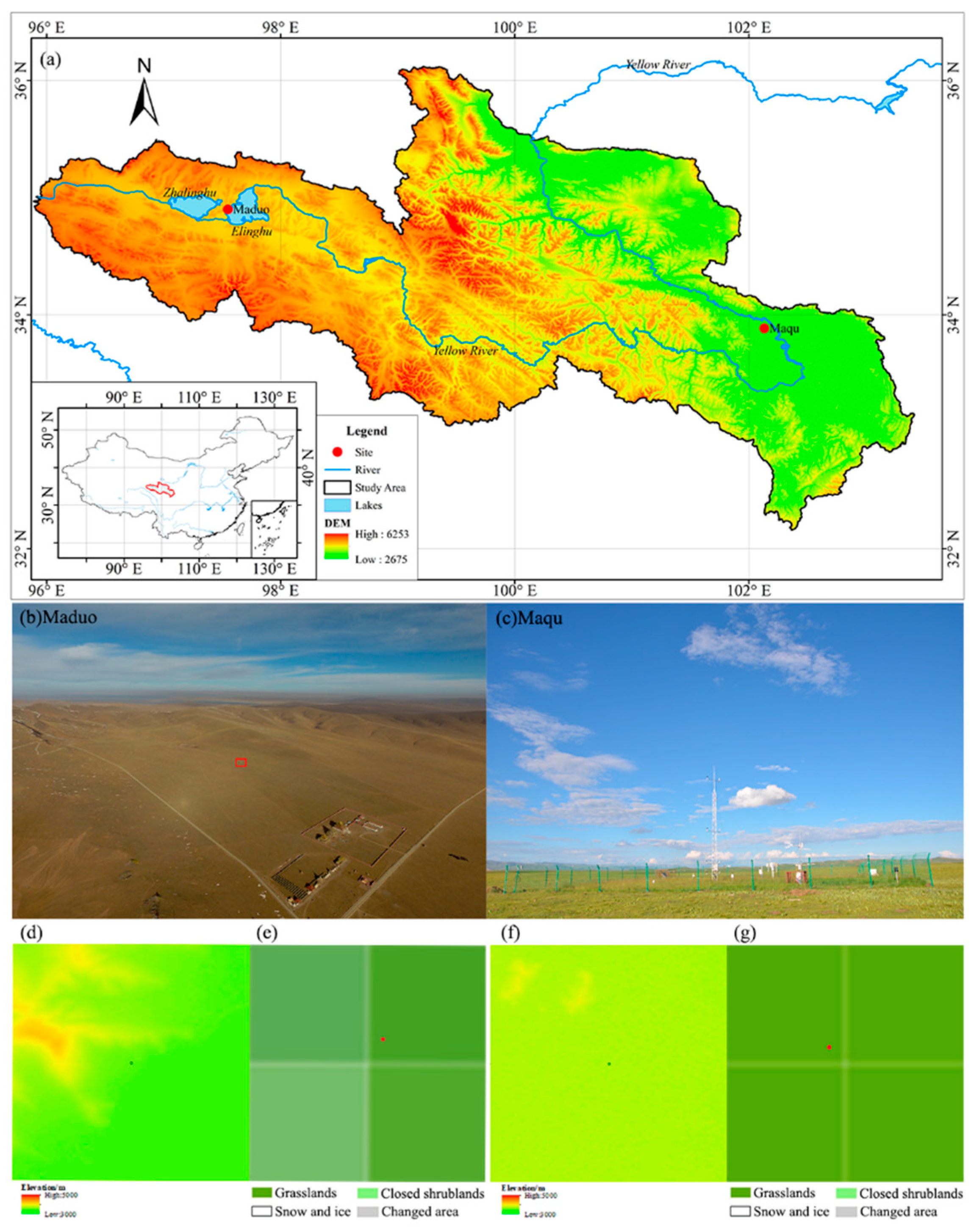


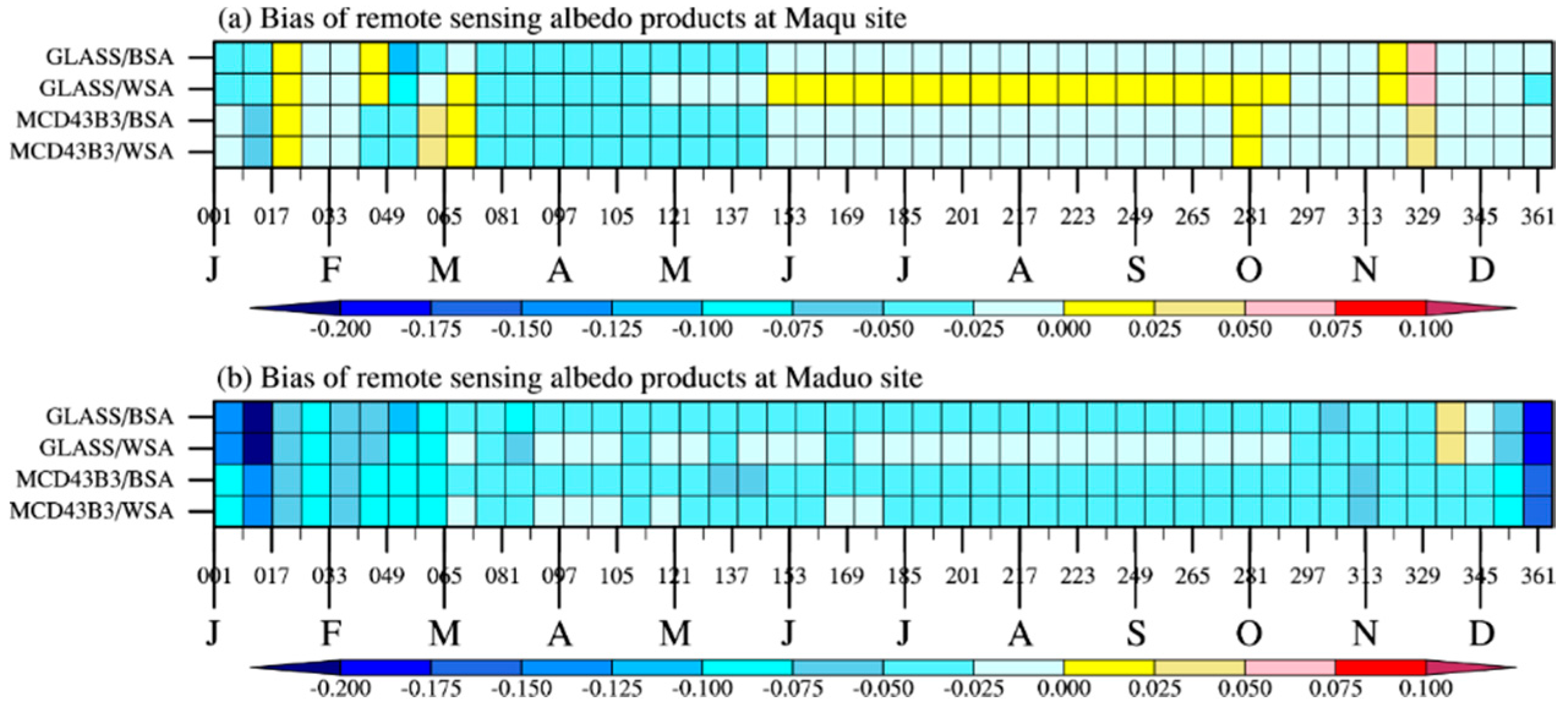
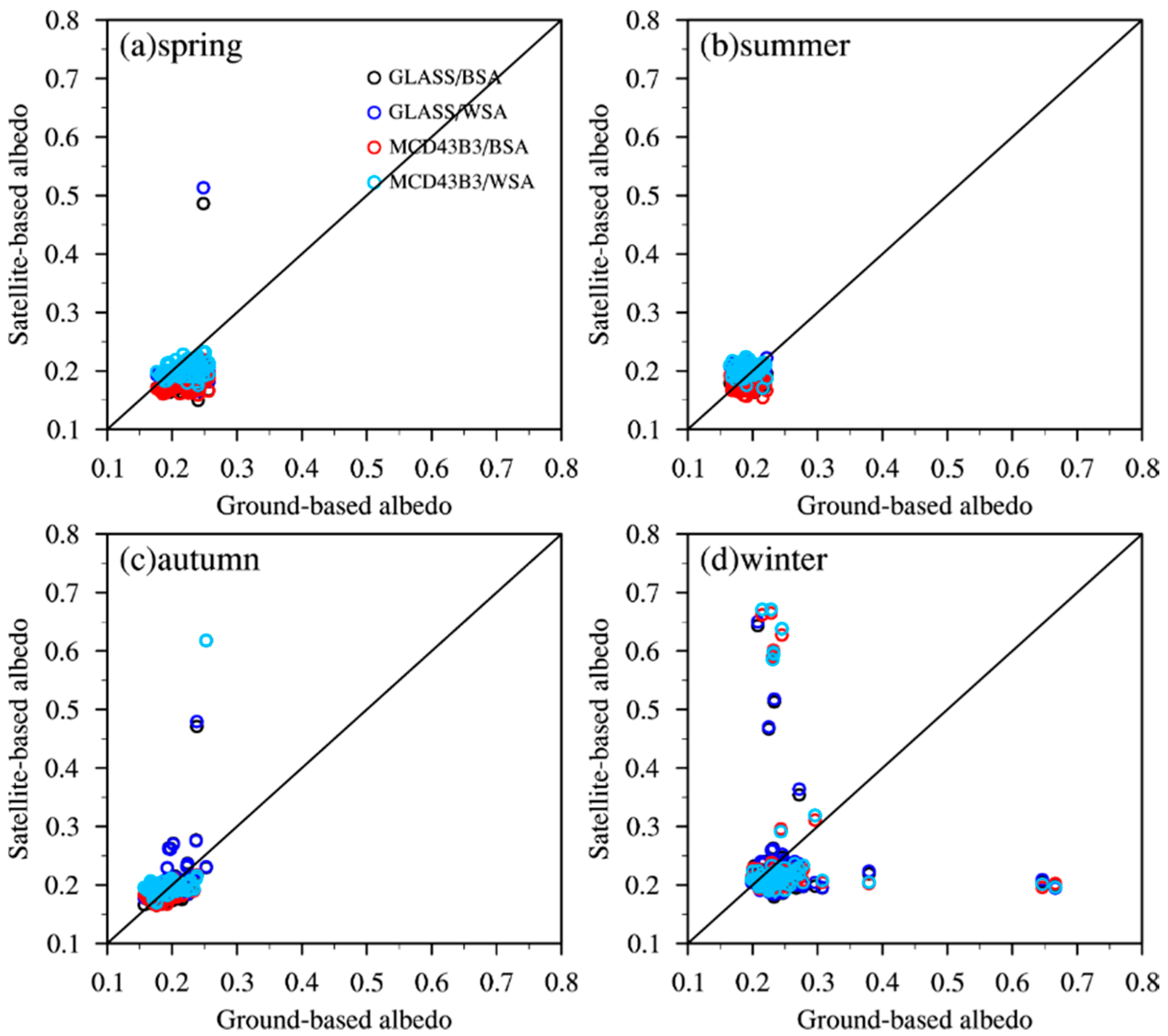

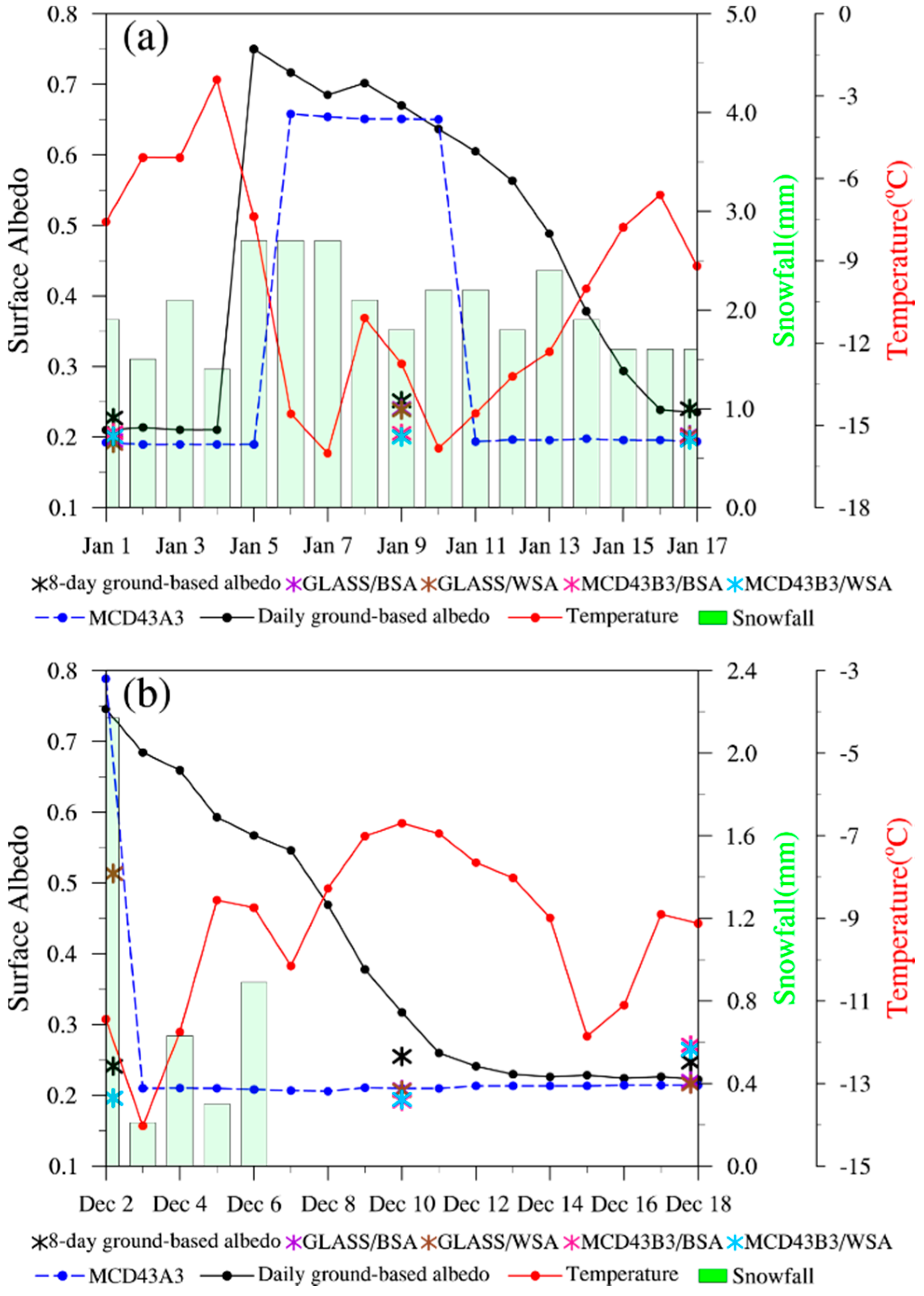
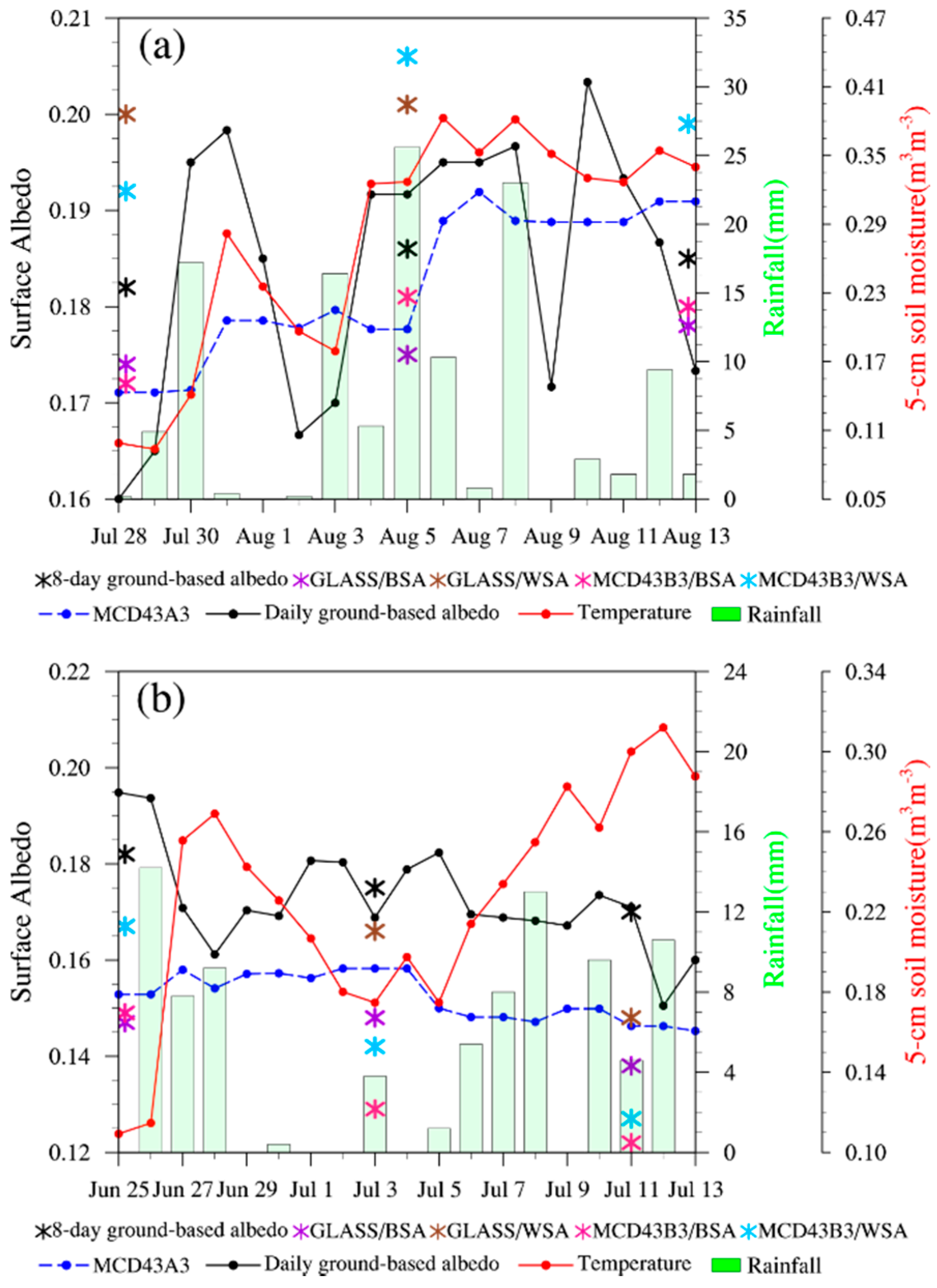
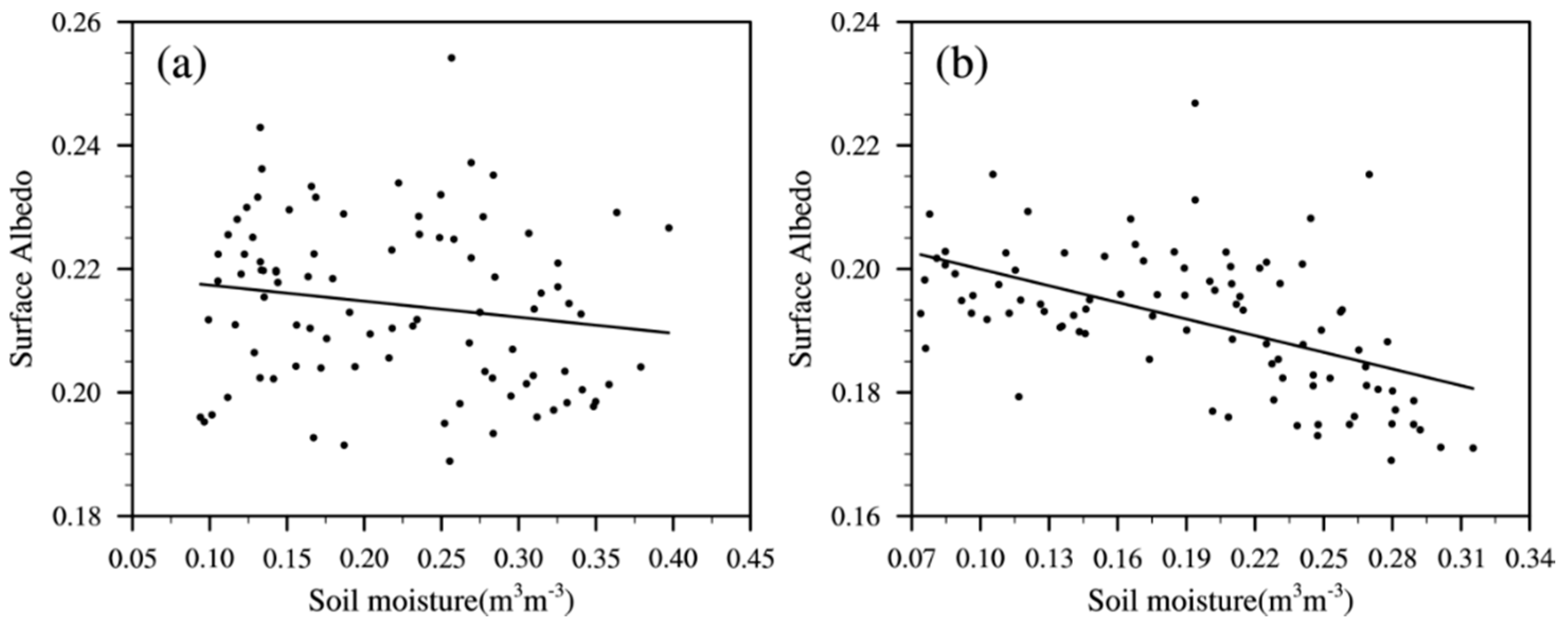

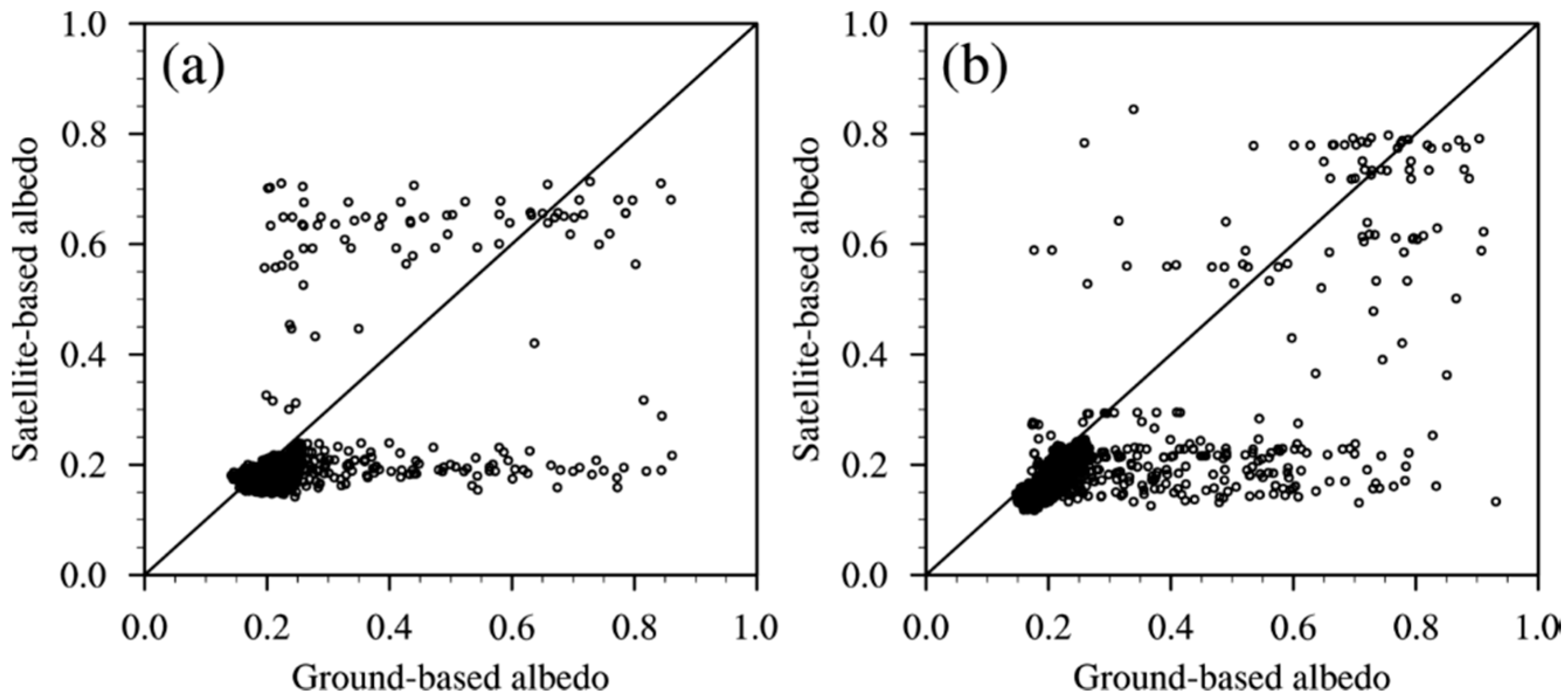
| Products | GLASS | MCD43B3 | MCD43A3 |
|---|---|---|---|
| Sensors | NOAA/AVHRR, MODIS | MODIS | MODIS |
| Satellites | NOAA, Terra, and Aqua | Terra and Aqua | Terra and Aqua |
| Included surface albedo data | BSA and WSA in three broadbands: shortwave (0.3–5.0 μm), VIS (0.3–0.7 μm), and NIR (0.7–5.0 μm) | BSA and WSA in three broadbands: shortwave (0.3–5.0 μm), VIS (0.3–0.7 μm), and NIR (0.7–5.0 μm); and seven spectral bands: 659, 865, 470, 555, 1240, 1640, and 2130 nm | BSA and WSA in three broadbands: shortwave (0.3–5.0 μm), VIS (0.3–0.7 μm), and NIR (0.7–5.0 μm); and seven spectral bands: 659, 865, 470, 555, 1240, 1640, and 2130 nm |
| Projection | Sinusoidal equal area | Sinusoidal equal area | Sinusoidal equal area |
| Spatial resolution | 1 km | 1 km | 500 m |
| Temporal resolution | 8-day | 8-day | daily |
| Algorithm | Direct estimation | BRDF modeling | BRDF modeling |
| BRDF synthesis period | 1-day | 16-day | 16-day |
| Temporal range | 2009–2017 | 2009–2017 | 2009–2017 |
| Site | Maqu | Maduo |
|---|---|---|
| Location | 33°53′N, 102°08′E | 34°54′N, 97°33′E |
| Elevation | 3423 m | 4300 m |
| Climate | Cold humid | Cold semiarid |
| Grassland vegetation | Rheum spp., Oreosolen wattii, Lagotis brachystachya, Saussurea graminea, etc. | Stipa purpurea, Urtica hyperborea, Microcaryum pygmaeum, Potentilla bifurca, etc. |
| Measurement height | 1.5 m | 1.5 m |
| Sensor type | CNR1 net radiometer | CNR1 and CNR4 net radiometers |
| Sensor manufacture | Kipp & Zonen (Delft, The Netherlands) | Kipp & Zonen (Delft, The Netherlands) |
| Spectral range | 0.3–50 micrometers (including shortwave radiation of 0.3–2.8 μm) | 0.3–50 micrometers for CNR1 and 0.3–42.0 μm for CNR4 (including shortwave radiation of 0.3–2.8 μm) |
| Uncertainty of pyranometer | (day total) | (day total) for CNR4’s pyranometer |
| Maqu Site | Maduo Site | |||
|---|---|---|---|---|
| RMSE | Bias | RMSE | Bias | |
| GLASS/BSA | 0.055 | −0.030 | 0.092 | −0.054 |
| GLASS/WSA | 0.052 | −0.026 | 0.088 | −0.045 |
| MCD43B3/BSA | 0.055 | −0.027 | 0.072 | −0.050 |
| MCD43B3/WSA | 0.055 | −0.027 | 0.070 | −0.046 |
© 2020 by the authors. Licensee MDPI, Basel, Switzerland. This article is an open access article distributed under the terms and conditions of the Creative Commons Attribution (CC BY) license (http://creativecommons.org/licenses/by/4.0/).
Share and Cite
An, Y.; Meng, X.; Zhao, L.; Li, Z.; Wang, S.; Shang, L.; Chen, H.; Lyu, S.; Li, G.; Ma, Y. Performance of GLASS and MODIS Satellite Albedo Products in Diagnosing Albedo Variations during Different Time Scales and Special Weather Conditions in the Tibetan Plateau. Remote Sens. 2020, 12, 2456. https://doi.org/10.3390/rs12152456
An Y, Meng X, Zhao L, Li Z, Wang S, Shang L, Chen H, Lyu S, Li G, Ma Y. Performance of GLASS and MODIS Satellite Albedo Products in Diagnosing Albedo Variations during Different Time Scales and Special Weather Conditions in the Tibetan Plateau. Remote Sensing. 2020; 12(15):2456. https://doi.org/10.3390/rs12152456
Chicago/Turabian StyleAn, Yingying, Xianhong Meng, Lin Zhao, Zhaoguo Li, Shaoying Wang, Lunyu Shang, Hao Chen, Shihua Lyu, Guangwei Li, and Yingsai Ma. 2020. "Performance of GLASS and MODIS Satellite Albedo Products in Diagnosing Albedo Variations during Different Time Scales and Special Weather Conditions in the Tibetan Plateau" Remote Sensing 12, no. 15: 2456. https://doi.org/10.3390/rs12152456







